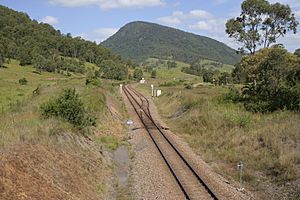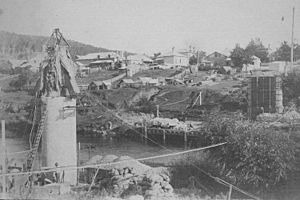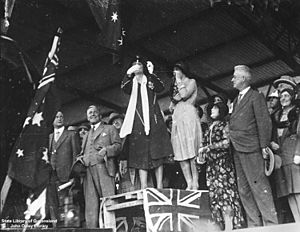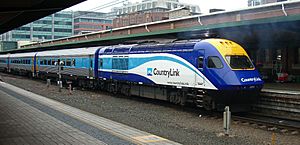North Coast railway line, New South Wales facts for kids
Quick facts for kids North Coast railway line |
|
|---|---|

|
|
| Overview | |
| Status | Open |
| Owner | New South Wales Government Railways (1905–1915) Department of Railways (1915–1972) Public Transport Commission (1972–1980) State Rail Authority (1980–2003) RailCorp (2003–2020) Transport Asset Holding Entity (2020–present) |
| Locale | Mid North Coast and Northern Rivers regions of New South Wales |
| Termini | Maitland Brisbane Roma Street |
| Service | |
| Type | Heavy rail |
| History | |
| Opened | 6 November 1905 |
| Technical | |
| Line length | 795 km (494 mi) |
| Track gauge | 1,435 mm (4 ft 8 1⁄2 in) standard gauge |
The North Coast railway line is a very important train route in New South Wales, Australia. It runs along the coast through the Mid North Coast and Northern Rivers areas. This line is a big part of the main train path between Sydney and Brisbane.
The railway starts in Maitland and goes all the way to Brisbane. However, trains carrying goods usually stop at Acacia Ridge, which is just outside Brisbane. Along its journey, the line passes through many towns. These include Dungog, Gloucester, Taree, Kempsey, Coffs Harbour, and Grafton. It also goes through Casino and Kyogle.
The North Coast line uses a standard gauge track. This means the rails are a specific distance apart. When it reaches Acacia Ridge, the line becomes a dual gauge track. This means it can handle trains with different track widths. It then runs next to parts of the Beenleigh railway line into Brisbane.
Since the Main Northern Line closed north of Armidale in 1988, the North Coast line is now the only train route connecting Sydney to Queensland. Some smaller train lines that used to connect to the North Coast line, like the ones to Dorrigo and Murwillumbah, are now closed.
Near the border between New South Wales and Queensland, there is a long tunnel called Border Tunnel. It is 1160 metres long and has only one track. Close by is the Cougal Spiral, a special part of the track that helps trains climb hills. The Transport Asset Holding Entity owns the line, but the Australian Rail Track Corporation manages it until 2064.
Contents
How the North Coast Railway Line Was Built
The first part of what would become the North Coast railway opened in 1894. This section ran between Murwillumbah, Byron Bay, and Lismore. It was later extended to Casino in 1903 and Grafton in 1905. A branch line was added to Kyogle in 1910. This line was then extended to South Brisbane in 1930.
The main North Coast line was built between 1905 and 1932. When it was finished, it offered a faster way to travel up the eastern coast of Australia. Building the line was tricky because of the many large rivers that flow through the North Coast region. The line also includes the Cougal Spiral, which is a unique railway design. A spiral helps trains climb steep hills by looping around.
A railway was built from Maitland to Paterson and Dungog in 1911. It was then extended to Gloucester and Taree in 1913. By 1915, it reached Wauchope, Kempsey, and Coffs Harbour. The last part of the line between Coffs Harbour and Glenreagh, which has five tunnels, was finished in 1922.
Crossing the Clarence River
The Clarence River was the hardest river to cross. Trains could not cross it until 1932. Before the bridge was built, special rail ferries carried train carriages across the river. The opening of the Grafton Bridge in 1932 finally completed the train link between Sydney and Brisbane. This was the first time a standard gauge railway connected two capital cities in Australia.
After the Sydney–Brisbane link was finished, the Casino–Murwillumbah line became a smaller branch line. Another branch line to Ballina was added in 1930 but closed in 1949. The Murwillumbah branch line closed in 2004. A scenic branch line from Glenreagh to Dorrigo opened in 1924. However, it was hard to keep open due to the steep land and heavy rain. It closed in 1972 after a part of the track was washed away.
Train Services on the North Coast Line

Current Passenger Trains
NSW TrainLink runs passenger trains on the North Coast line every day. There are three daily XPT services from Sydney. These trains go to Grafton, Casino, and Brisbane. There are also many weekly services from Newcastle that end at Dungog.
Past Passenger Trains
In the past, the most important passenger trains on this line were the Brisbane Limited and the Brisbane Express. The Limited was the fastest train, stopping only at big stations. The Express stopped at more stations, especially north of Grafton. It also connected to trains on the Murwillumbah branch line. From 1960, the Brisbane Limited had sleeping cars with air conditioning.
In 1973, the Brisbane Express was replaced by the Gold Coast Motorail, which went to Murwillumbah. Other trains like the North Coast Daylight Express and North Coast Mail ran to Grafton. These were later replaced by a single Holiday Coast XPT train in 1985. In 1990, the Brisbane and Murwillumbah services also became XPT trains. The Grafton Express was introduced in 1990 and also became an XPT service in 1993.
Freight Services
When the Main North Line closed north of Armidale in 1988, large freight trains started using the North Coast Line to reach Brisbane. Today, companies like Pacific National and SCT Logistics operate these freight services. These big freight trains usually do not stop at the towns they pass through. In the past, government railways had regular freight services to towns like Kempsey, Grafton, and Casino.
Currently, one of the few regular freight trains on the North Coast Line carries cement and sugar to Grafton. This service is run by Pacific National.
Improving the Railway Line
The North Coast Line has many curves. It is like turning through 150 circles along the way! This means that trains often have to change their speed. Freight trains usually travel between 60 km/h and 115 km/h.
The Australian Rail Track Corporation has been working to make the line better. They have replaced old wooden sleepers with new concrete ones. Sleepers are the pieces of wood or concrete that support the rails. They have also updated the signals and added new loops. Loops are extra sections of track where trains can wait or pass each other. These changes help trains run more smoothly and efficiently. In 2011, they also made about 58 curves on the line less sharp. This allows XPT and freight trains to travel faster. These changes were made without buying new land, so the track stayed within its existing area.
|





